
You’ve probably read post-apocalyptic books or seen post-apocalyptic movies where an EMP initiates a collapse. Those might demonstrate ways to survive an EMP attack, but fiction and reality are often worlds apart.
We’ll dig into all of this, but first – what exactly is an electromagnetic pulse?
What is an Electromagnetic Pulse?
An electromagnetic pulse, or “EMP” for short, is a sudden burst of energy that overloads the fragile components within an electrical system, causing them all to short out. It causes actual hardware damage resulting in the failure of any unprotected electrical devices.
The likely threat of an EMP would be from a high-altitude nuclear blast. However, non-nuclear directed energy devices and specialized conventional weapons (such as SCUD missiles) could also be used to generate an EMP (source).
Geomagnetic storms also create EMPs. In fact, it’s happened before, the most notable time being the 1859 Carrington Event, which filled the sky with a celestial light show – and sent massive currents through electrical wires, destroying telegraph machines. This was at a time when the world was far less dependent on electrical devices, however, so the impact did not disrupt everyday life. If the same event were to happen today, the impact on modern society could be nothing short of devastating.
Is an EMP an Actual Threat?
Essentially every aspect of American society requires electrical power to function. Contemporary US society is not structured, nor does it have the means, to provide for the needs of nearly 300 million Americans without electricity. – The EMP Commission Report
There is no question that an EMP is real and serious threat, but there is a wide variety of discussion on how likely of a threat that it is.
Ted Koppel, author of Lights Out, considers an EMP attack to be the least likely way an attacker would attempt to take down the U.S. electrical grid (believing a cyberattack is more likely). The effects could be the same, but there is a growing movement within the U.S. government to protect itself against EMP attack.
In April of 2015, the Pentagon relocated the North American Aerospace Defense Command’s (NORAD) computer systems to a bunker buried deep beneath Cheyenne Mountain in Colorado. NORAD is the nation’s first line of defense against enemy attack.
In 2008, the U.S. government assembled a panel of scientists (chaired by William R Graham – the premier EMP researcher in the country) from a variety of EMP, nuclear, and national defense-related disciplines to analyze the threat level of an EMP attack. Their report was called The Report of the Commission to Assess the Threat of the United States from Electromagnetic Pulse (EMP) Attack.
Buy a paperback copy of the Commission’s report.
General Lloyd Austin, commander of CENTCOM, stated that an attack to take down a major section of the U.S. grid was not a question of if, but of when. George Cotter, the former chief scientist of the National Security Agency, wrote in his April 2015 white paper (titled Security in the North American Grid – A Nation at Risk) that, “when such an attack occurs, make no mistake, there will be major loss of life and serious crippling of National Security capabilities.”
And for good measure, when such an attack does finally occur, FEMA agency administrator Craig Fugate stated that the US does not have the tools required to get the grid back up and running quickly.
Watch this video featuring a retired Navy SEAL for a summary of what would happen should an EMP strike hit the U.S.:
This raises the next question…
Who Could Attack the United States with an EMP?
If we set aside an “attack” by the sun in the form of a geomagnetic storm, an EMP would most likely come from the high-altitude detonation of a nuclear weapon. Any nation that has nuclear weapons would be capable of posing an EMP threat to the United States.
Currently, that means any country in the nuclear club could launch an EMP attack. For the U.S., the biggest threats would come from Russia, China, and Pakistan. Iran and North Korea are two countries eager to expand their nuclear programs, so they are also threats.
In 2004, Russia admitted that North Korea had recruited several Russian nuclear and EMP scientists to develop its attack capabilities. In May 2013, former head of CIA R. James Woolsey, wrote in a Wall Street Journal article, How North Korea Could Cripple the U.S., that North Korea was indeed an EMP threat to the US, and suggested the necessity for a preemptive strike. In November of 2013, the South Korean National Intelligence Service was able to confirm that North Korea was developing its EMP attack capability.
There is also the threat that a terrorist cell could acquire or steal the capability. They would not need an inter-continental ballistic missile to make it happen. It could be launched from a simpler missile off a cargo ship floating just offshore.
What Would Happen in the Immediate Aftermath of an EMP?
Imagine this. You’re sitting at home watching TV as it snows outside. All of a sudden, everything just goes out. You are about to live through one of the most life-changing experiences in modern history. You probably wouldn’t even know it at first, thinking instead that it’s just another problem with the power company.
Well, just like you, everybody else lost power as well, and depending on where the detonation occurred, and how many EMPs were launched, the impact could be felt across giant swaths of the United States – crippling us as a nation.
Not only is the power out, but electrical devices are fried. Your refrigerator won’t turn on even with a generator. Your cellphone doesn’t work. You can’t get cash out of the bank. No one can process credit card payments. People on life support start dying.
The EMP Commission Report analyzed vehicles made from 1986 to 2002 and found that the majority of them were still operable even after a simulated EMP attack. They simply needed to be restarted. However, the damage caused by the confusion and subsequent car accidents would create unheard of traffic congestion throughout the country – particularly at busy intersections and in urban areas.
People can band together and get through tragedies when they see an end in sight. But with aftereffects of an EMP strike, there would be no end in sight. Think you saw a rush for the supermarkets at the onset of COVID-19? After an EMP, total and complete mayhem would ensue. Those who needed refrigerated medicine, dialysis, and other electrically driven healthcare items would be the next group to die.
What Would Happen Within a Week of an EMP?
People throughout the nation would grow used to the site of American migrants and refugees walking past their front door. Much like refugees traveling from war torn countries, they would be carrying everything with them that they had on their person at the point of The Pulse. Most would have grown used to the daily knock at their door – another person asking for help – food, water, shelter, a ride, medicine, a coat – anything. The stories that would be heard over EMP-hardened ham radio emergency frequencies and from migrants would be both terrifying and heartbreaking.
Food and Water Supplies
It’s been widely theorized that after 3 days with no new food supply society begins to break down. A study indicated that about 40% of Americans do not keep more than 3 days’ worth of food and water at their home at any given time. In addition, grocers only stock 1-3 days’ worth of food on their shelves. Keep in mind that much of the food in coolers and freezers will have spoiled.
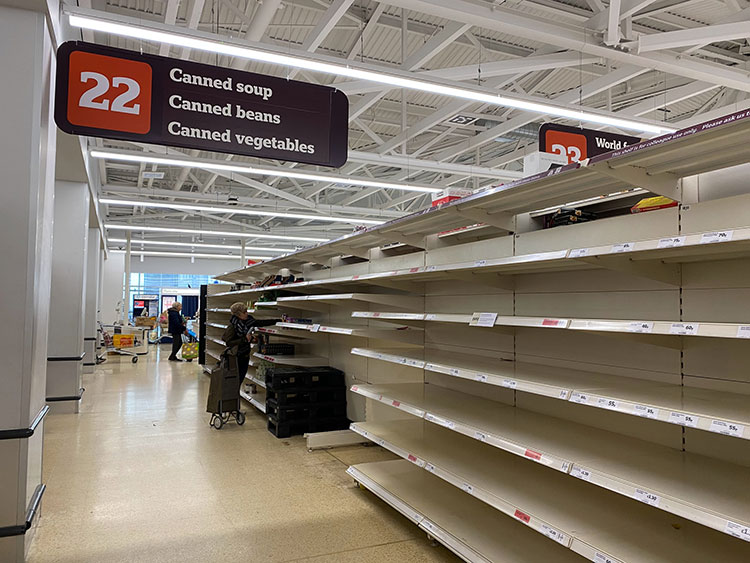
There would be total and complete chaos once the food ran out. Riots and violence would occupy the streets as hunger gradually gave way to desperation. In an effort to both escape the anarchy around them and to find food of some sort in rural environments (whether that be via charity, theft, or wages) there would be mass migrations from the cities of those who were still alive.
In a similar vein is the availability of potable water. Trains typically carry the chemicals needed to purify water for urban environments. Should an EMP devastate the electronics in the nation’s locomotives, there slim chances that the necessary chemicals for water purification would ever find their way to the cities. Without access to clean water, personal hygiene would quickly disintegrate, and there would soon be an outbreak of waterborne and hygiene-related diseases, such as cholera, hepatitis, giardia, and more.
Currency and Economy
Americans would very quickly resort to a barter economy for goods and services. The U.S. dollar, once the most sought-after dollar in the world, could have no value whatsoever. Fewer people would accept cash as it does not satisfy the immediate needs of survival. Preppers who stocked silver may have better odds of using that as currency.
Growing Transportation Problems
Though the EMP Commission Report seemed to indicate that cars from 1986 to 2002 would generally still function, the report did seem to indicate that running out of gas would be a larger issue. Vehicles from 2002 and prior still may have the capability of running, but if there is no longer any gas due to refineries being taken out of commission and transportation being an impossibility, it’s a rather moot point. Having a car without gas is like have a gun without ammunition.
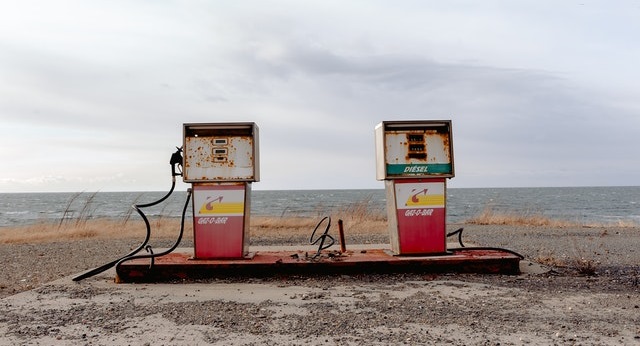
Who knows when they would be filled again.
Think you would be safer in rural areas? How will trucks carrying the necessary products to support daily life make it to the countryside? How would you get to work? Not that the work commute would matter. You would likely no longer have a job. No income. No clear indication things will return to normal – ever again.
What Would Happen Long-Term After an EMP?
According to the EMP Commission Report, one year after such an attack, only 10% of Americans would still be alive. The other 90% would die from starvation, societal chaos, and disease. According to Newt Gingrich, an EMP attack would throw our entire society back into the Middle Ages.
Law and Order
Rule of law would resort back to a tribal level. Small towns and groups of people would have insulated themselves against outsiders, and as such, would have their own laws. Turf wars would have taken place as various clans fought over resources. Brutal violence would be commonplace.
Food Production
There are fewer farmers today than there have ever been in U.S. history. Currently, 2% of Americans feed the other 98%. This was made possible through advances in technology. Industrial farmers can now plant more seed faster and over wider areas than we ever before.
Similarly, harvesting is electrically driven. Crippling farming technology would very quickly lead to starvation. Those precious few with a knowledge of older farming techniques, working small scale farms, and saved seeds would hold life-saving information. However, they would not be able to scale up quickly enough – if they survived. Farms would be immediate targets in such a prolonged crisis.
Absence of Wealth
Even if the power got back up and running, there would still be a permanent loss of individual and institutional wealth. Of the 10% of Americans who would survive the effects of an EMP blast, they would likely be starting again from nothing. The only wealth that they would have at this point would have come from their bartering ability, their ability to steal, or from their ability to provide vital services such as blacksmithing, farming, medical work, and the like.
Prolonged Lack of Electricity
It is very unlikely that things would ever get back to “normal” in what would be considered a timely fashion. The truth is that the time it would take to get the power up and running throughout the country would be years. One of the reasons for this is because of large power transformers.
The large power transformers (LPTs), which are essential to the power grid, would likely be irreparably damaged. Virtually all these LPTs are individually tailored for the locations in which they serve. This means that there are seldom interchangeable parts.
There are a limited number of companies within the US that had the capability of building an LPT, and when they do so, it often takes in excess of 6 months before the final product is actually delivered. When the LPT is delivered it is so massive that it requires specialized equipment in order to do so. Many LPTs were put into place with railways which no longer exist. To deliver one to a location that does still have easy access to a railway, a specialized freight car known as a Schnabel is required.
As you can see, getting the power back up and running would most likely not be accomplished within a year.
How Will the Government Respond?
There are several steps that the US government has taken to protect the nation against an EMP. The first main step that they took to protect the nation against EMP (that we know of) was the EMP Commission Report in 2008. That report took a detailed look at the effect which an EMP attack would have on a variety of different sectors of society such as transportation, water infrastructure, food logistics, and more. Since that time there have been other steps that have been taken at the federal level.
On October 13, 2016, President Obama signed Executive Order 13744 – Coordinating Efforts to Prepare the Nation for Space Weather Events. Though not a de facto EMP attack preparedness plan, planning for space weather events overlaps significantly with hardening one’s resources against an EMP. It wasn’t long after that when FEMA and the Department of Energy (DOE) developed a report known as the Power Outage Incident Annex: Managing the Cascading Impacts from a Long-Term Power Outage in 2017.
Then on March 26, 2019, President Trump signed into effect Executive Order 13865 – Coordinating National Resilience to Electromagnetic Pulses. This order started a cascade of federal decisions beginning with the Department of Homeland Security’s research of evidence-based EMP mitigation techniques to protect critical infrastructure.
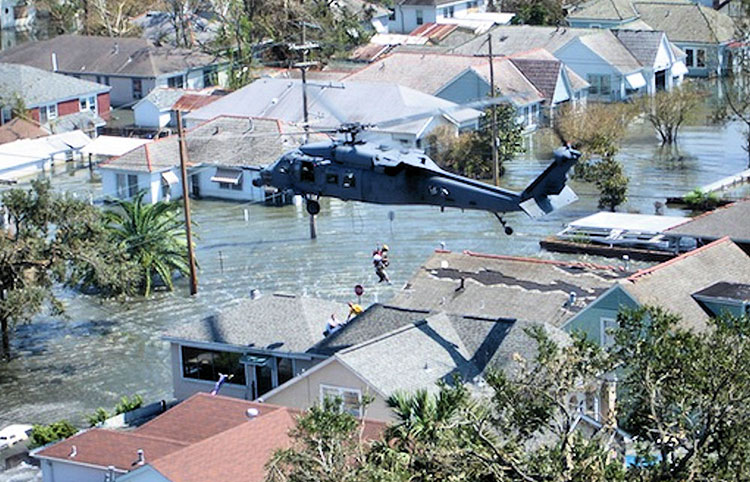
These steps should not put you at ease, however. The government, as we witnessed with Hurricane Katrina and the COVID-19 pandemic, has a horrible track record with organizing resources and assistance in times of disaster. Red tape, inefficiency, and incompetence creates their own problems. What’s more, the federal government will be intent on retaliating against any enemy forces behind the attack. The United States would be waging war on one hand, and trying to help its own people on the other.
If a large-scale, devastating event like an EMP strike hit, you should expect to be on your own. This leads us to…
7 Things You Can Do to Prepare for an EMP
“At some point, this is on the individual member of the public to do a little bit to plan for that contingency.”
– Jeh Johnson, Secretary of the Department of Homeland Security while speaking on the threat of massive power outages.
#1 – Beans, Bullets, and Band-Aids
“Beans, bullets, and Band-aids” is a prepping mantra that drives home the overarching aspects of personal preparedness. These tenets that apply to various SHTF scenarios apply here as well. Beans, bullets, and Band-aids represent the first of our ways to survive an EMP attack because they cover all of the key components.
Do you have at least some food stored for your family? Do you have the means and knowledge of how to defend yourself in case of an attack? Do you have a stockpile of common medications, a knowledge of basic first aid, and the other necessary medical supplies that you may need in case you no longer have access to a doctor? Do you have a plan?
According to the EMP Commission Report, within one year after an EMP attack, 90% of the US population could be dead. This will be due to starvation, lack of appropriate medical care, violence, and infectious diseases. As such, it is vital that you fall back on the prepper staples of “beans, bullets, and Band-aids” if you want to have any chance whatsoever of surviving an EMP blast.
If an EMP never hits – no problem – your BBBs will cover your prepping needs for other catastrophes, short or long-term.
Beans
Seeing that lack of food due to lack of transportation, lack of harvesting equipment, lack of processing equipment, lack of refrigeration, and lack of crops being planted is going to be a significant issue post-EMP, one of the most important things that you can do to keep your family safe is to begin storing food.
Only within the past few decades have Americans forsaken the food larder. For millennia, mankind has stored at least a winter’s worth of food within his residence so that he could stay alive until the next growing season. Stocking a larder can be done fairly inexpensively.
“Beans” is used to refer to food in general. Beans themselves, however, are a great place to start – beans and rice. They are cheap, store very well in Mylar bags with oxygen absorbers, and can keep you alive for a long time. The details of how to build a long-term food storage goes well beyond this article, but to get you started you can read about building a prepper pantry, foods that store well, bulk survival food deals, and – of course – long-term coffee storage.
And don’t forget water – lots of stored water and multiple ways to purify it!
Bullets
Surviving an EMP in the initial phase is easy. In fact, there’s nothing you have to do to survive the actual pulse itself. It’s the aftereffects that represent the danger – too few supplies for too many people.
If you’ve properly prepared, and people know it, they will come knocking on your door. As this old Twilight Zone episode illustrates, it’s imperative to not disclose the fact you’re prepping and to keep your preps hidden.
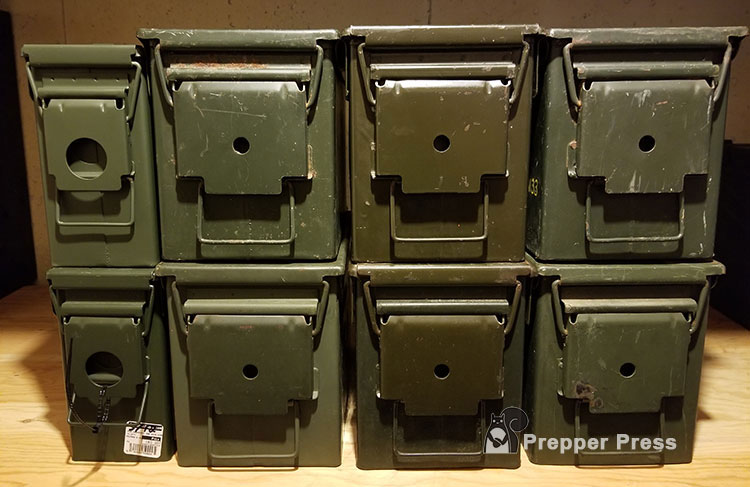
However, even if you do all of that, starvation will inevitably get to people. It’s one thing to fall victim to starvation, quite another to watch your child or loved one starve before your eyes. It’s the latter that will prompt people to take steps they would have never imagined themselves taking before. Will you be ready to defend you, your family, and your preps?
Stock up on a basic inventory of firearms and – in particular – shop for bulk ammo deals. Get the ammo cheap and stack it deep.
Band-Aids
“Band-aids” is like “beans” – a word to describe a larger category, in this case – medical care. Should you become an EMT as a matter of medical preparedness? You don’t have to, but it also wouldn’t hurt. What matters most is some basic level of knowledge on medical care and having basic medical equipment stored so you can meet short-term needs. You won’t be able to treat cancer after the apocalypse, but you could splint a broken bone. Find a balance in your medical preps.
Pay close attention to your medical needs and the needs of your loved ones. What prescriptions do you need? Do you have enough stocked so if there was a disruption in the supply chain you would be okay? Plan this out in your threat assessment.
Consider having these two books on hand: Where There is No Doctor and Where There is No Dentist. Both can be downloaded as free PDF files or – as I recommend – purchased as paperback books. Remember, we’re talking a long-term grid-down situation here where electronic devices have been rendered useless. You won’t want to have to rely on accessing a PDF in a time of medical need.
Other medical books to consider adding to your prepper bookshelf include:
- Davis’s Drug Guide for Nurses
- Department of the Army’s First Aid Manual
- Emergency War Surgery
- Tactical Combat and Casualty Care and Wound Treatment
#2 – Have Alternative Communication Plans
We crave information, and the possession of information is a very powerful tool that not only allows us to make better decisions but helps ensure safety.
Immediately following any disaster, there is a series of steps information-wise that an individual will go through. The first thing is the desire to know that they, their families, and their close friends are all safe. Once this knowledge is secured, the next thing one will want is information on the disaster itself.
What just happened? What are the immediate consequences of such? Were we just attacked? What should I do to protect my family against such a disaster’s consequences? After this, you’ll want to know information on recovery. What steps must I take to get “back to normal”? What will that look like?
One of the more important (yet often overlooked) aspects of preparing for an EMP is to ensure that you have appropriate disaster communications gear in place before such an event happens. Information is vital to making wise and safe decisions, staying in touch with family, knowing what is happening locally, nationally, and even globally. Disaster communication abilities enable you to both find and protect your family post-pulse.
Buy a Ham and CB Radio
I believe that Rawles’ depiction of post-collapse family communications (where the entire family is a dedicated “ham” with Morse code knowledge) is rather far-fetched, but it is very easy to install a President McKinley SSB radio in all of your vehicles or to place a UV-5R in all of your vehicles for disaster purposes only. The UV-5Rs are so cheap it’s almost an obvious decision to stock a few.
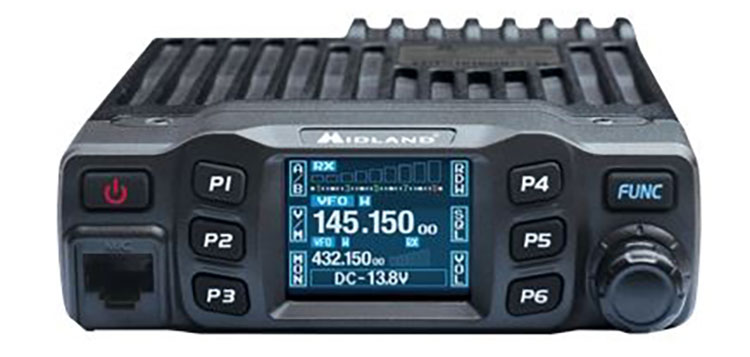
Midland Radio is a great company for buying various types of grid-down communication equipment. Of particular interest are their micro-mobile units, ham radios, and CB radios.
#3 – Protect Vital Electronic Equipment
If you’re paying attention, you were probably struck by my second point of advice – buying alternative communication gear, thinking: Wait, you said electronic equipment would be destroyed, now you’re saying buy some? Correct. Electronic equipment will survive – if it’s protected.
A Faraday cage is the common means of protecting electronics from an electromagnetic pulse of geomagnetic storm. A what? you might ask.
A Faraday Cage, sometimes known as a Faraday Shield, is an enclosure that is used to shield things from electromagnetic fields (both static and non-static).
https://interestingengineering.com/how-does-a-faraday-cage-work
Build a Faraday Cage
If you are planning to protect extensive amounts of electronics you will probably want to build a Faraday cage. There are only instructions on how to do this from Backyard Brains, PC Mag, and Sciencing.
If I was building a Faraday cage, I would opt to build a box similar to what Mission Darkness demonstrates in the following video. The directions are clear and all of the necessary components can be purchased right here. In fact, they have the products you could use to protect an entire room!
If you shop there, use coupon code “SHTFBLOG” for an additional 5% off.
A “cage” of this nature will protect a serious amount of electronics. It would be perfect for storing electrical equipment that is not in use on an everyday basis, because it would all have to be contained within the cage at the time of the EMP strike, and no one knows when that could happen.
Buy a Faraday Cage
If you’re not handy, don’t have the time, or just don’t need something as large as an entire box, buying a Faraday cage is probably a wiser move. This a convenient, quick and easy way to protect equipment. Here are some shopping options:
| Product | Retailer Link(s) |
|---|---|
| Non-Window Faraday Bag for Phones | Mission Darkness and Amazon |
| Faraday Tablet Sleeve | Mission Darkness |
| Faraday Window Bag for Laptops | Mission Darkness |
| Faraday Duffel Bag with MOLLE | Mission Darkness and Amazon |
| Faraday Backpack | Mission Darkness and Amazon |
| Faraday Car Cover (the Mothership product) | Mission Darkness |
Buying a Faraday cage has been my choice of action. There are not a ton of electrical components that I strive to protect, mostly just basic communication equipment like the UV-5R that I could recharge with portable solar panels or other non-grid charging devices.
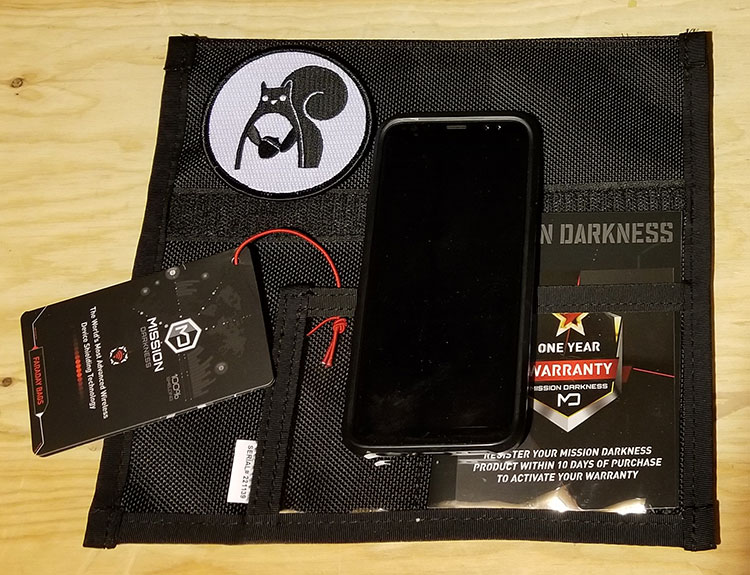
You can read our review of the Mission Darkness Faraday phone sleeve here. You can watch our YouTube review of the duffel bag here.
Remember: Regularly store electronics inside the Faraday cage if you want them to stay protected. At the risk of stating the obvious, a Faraday cage will be useless if your equipment is sitting outside of it when an EMP strikes.
Bonus: The Faraday sleeves will protect your phone, tablet, PC and anything else inside it from hackers. That gives these products real world, practical uses today, not just for EMP protection.
#4 – Build Get-Home or Bug Out Bags

Every important plan needs a Plan B. Plan B, in prepping, usually means vacating the area. Say, as an example, an EMP or geomagnetic strikes the Northeast. For whatever reason, maybe a poorly launched missile or position of the Earth at time of the solar flare, only the Northeast is struck. I live in Maine. Life would suddenly get really tough here.
However, I have family in Florida. If life in every state from Connecticut north into eastern Canada came to a screeching halt and chaos ensued, would it not make sense to seek safety in Florida? Of course it would. Hence – bugging out.
We here at SHTF Blog make a big point of encouraging people to have a well-equipped bug out backpack. That’s for good reason. Plans, no matter how good they are, can fail. You must have options, and sometimes the only option – as in war – is retreat. Holding your ground in the face of death is one thing. Holding your ground in the face of your children’s deaths, that’s something else.
Ensuring that your family members have what they need to stay safe and to survive while they are heading to a rally point post-disaster is important. A well-stocked survival kit does not take up much space within a vehicle, and even children can carry some small amount of supplies unnoticed in the bottom of their bookbags.
Make sure your bug out bag has everything needed to get you from Point A to Point B. This includes, but is not limited to, fire starters, cookware, and bug out guns.
#5 – Prep for Life Off the Grid
There is a strong focus within the prepper community on having alternative sources of energy, whether they be going off the grid with solar panels or having a back up generator. All of that is well and good, particularly in times of natural disasters when power is cut off for a finite period of time. A better way to prep might be to plan for life without power at all.

If you want to be able to cook at home during a natural disaster when the power is out for a few days, having a back up generator to power your electric range will work fine, as would having a gas range. But in an EMP situation, your generator may not work, or if it does, you will sooner or later run out of gas, even if you know how to store gas for a long time. It will still run out. The same can be said of that propane tank fueling your range. When an EMP strikes, resupply lines will be non-existent.
You will have serious problems when the grid fails if you must have power in order to cook and stay warm. What is better than natural gas or oil heat for survival? A woodstove. What is better than an electric stove and oven for survival? Knowing how to cook over an open fire with cast iron cookware will be critical. Knowing how to grind and roast coffee beans will soothe the soul. You get the idea.
#6 – Have a Family Plan
I mentioned the theoretical scenario where an EMP hits the Northeast but not the South. Would my family in Florida know to expect me if they couldn’t get in touch with me? Likewise, if the situation was reversed, would I know they plan to come to Maine?
Having a family plan is important in any sudden survival situation. Does everyone know where to go, what to do, and what third party to reach if society suddenly falls apart? A collapse is terrifying enough, let along a collapse and not knowing where your family is or when/if you’ll see them again. Have a plan!

Having something of a rally point plan with your family is another means by which you can decrease post-disaster chaos for your family. Have a pre-planned and agreed upon place that your family will all meet should something bad happen. In most cases this will likely just be your house, but home may be inaccessible. What then?
Create a family emergency plan well ahead of time. Make sure that everyone in your family knows what is expected of them, and where the rally point is should there be some type of disaster which occurs while everyone is out of the home. Should an EMP strike at 11AM, there is a very good chance everyone in the family will be in different locations. Having a plan of some sort will eliminate the guesswork involved with wondering where your family is and whether they know what to do.
#7 – Create Groups NOW
There is safety and strength in numbers, and the time to improve your disaster resiliency through such is now, not post-disaster. Get to know your neighbors and colleagues now, particularly those of a similar mind. Within my community, there is a growing understanding that things are only going to get worse, and so there is a sizable group of us who are doing what we can to prepare for the future to the best of our ability.
Creation of some form of mutual defense force will need to be accomplished as quickly as possible post-blast as well. In a world ruled by violence, if you can’t protect it, you won’t own it for long. There is safety in numbers, and you’ll need to be organized.
By creating groups now you’ll already have a community in place in the event of a post-pulse world, and you’ll have something of a game plan to work from for providing for your families and protecting those you love. Through groups you have shared supplies, resources, and know-how. What you might know how to do your neighbor might not, and vice-versa.
How to Survive an EMP Summary
Though it may appear that an EMP attack is an inevitable doomsday scenario, it is not a harbinger of fatalism. There is still something that can be done on the individual and collective level to better mitigate the personal risk from such a disaster, and thankfully, much of this already falls under the umbrella of the practices that a prepper follows every day.
Stock beans, bullets, and Band-aids. Have alternative communication equipment. Protect that equipment. Build and maintain bug out bags. Prepare for life off the grid. Have a family plan. Create groups now. Take these recommended step and you will be far better prepared than 99% of society.
If you have other thoughts on EMP preparedness, let us know in the comments!

4 comments
A good book that is probably very accurate is ‘One Second After’ by William R. Forstchen.
Second the book above. Excellent prognosis on the disaster and resulting “normal”.
Ditto on that book. And I loaned it to a number of friends who both enjoyed the read and learned a lot.
Great Video!
Russia, China, North Korea and Iran, playing with high-altitude HEMP bombs, which can be even MORE devastating, because they can even fry electronics that are NOT connected to the grid, such as phones and flashlights. In fact, Russia sold such devices to North Korea in 2014 [4] [5].
If you’re still skeptical about N. Korea’s abilities, keep in mind that they now have TWO satellites orbiting the Earth at low altitude, the KMS-3 launched in 2012 and the KMS-4 launched in 2016.[6]
…and guess what? They both hover OVER the United States[7]!